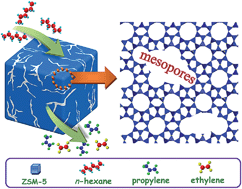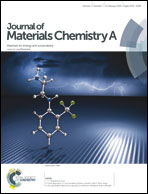Postsynthesis of mesoporous ZSM-5 zeolite by piperidine-assisted desilication and its superior catalytic properties in hydrocarbon cracking†
Abstract
Mesoporous ZSM-5 zeolites with unique hydrocarbon cracking properties have been postsynthesized from conventional ZSM-5 samples using small molecular organic amine-assisted desilication technique. The parent ZSM-5 zeolites, with regular crystal size of 1–2 μm and Si/Al ratios of 15–500, were first hydrothermally synthesized using inorganic silicon and aluminum sources and piperidine as structure-directing agent (SDA) with the assistance of active seeds. Controllable mesopores were successfully introduced into as-synthesized ZSM-5 crystals by alkaline-derived desilication with the addition of piperidine or hexamethyleneimine. The addition of organic amines shielded the zeolite crystals from extensive dissolving by NaOH attacking. The mesopores were thus generated controllably within zeolite crystals and also minimized the loss of microporosity and solid acidity. The incorporation of mesopores made the micropores well interconnected, shortened the average diffusion path lengths as well as maintained more catalytic active sites showing a higher propylene yield and a longer lifetime in the cracking of n-hexane.


 Please wait while we load your content...
Please wait while we load your content...